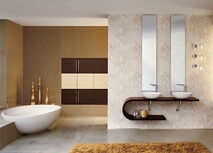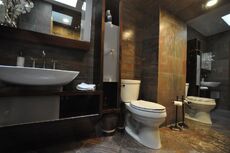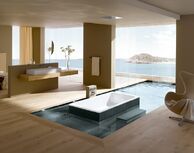In this weeks studio class, we allocated who will be doing what group presentation later in the semester. I chose the topic of Intellectual Property for our group. This decision came about because it seemed like the most relevant topic to our project. We are using a number of different companies property to create our own system, so I thought it would be nice to investigate exactly how we are and aren't allowed to use this property. Our presentation most likely also cover how we are creating our own IP and how we as a group can protect it. This topic is also very relevant to us as students and as future designers, so I think it will be very useful to look into.
As a group, we talked with Stephen and Russell about our project. We looked at what we were planning on achieving as a group and how we should go about achieving it. Me and Matt both feel that our main problem is going to be the Kinect and how we will get it to function within a system running a number of different things at once. Stephen has some code that works with the CryEngine already, but that doesn't necessarily mean that it will do what we want it to do.
Me and Matt talked about how we think we can move the Kinect around the room to track a person as well. This is because of the limited view range of the Kinect, and the possibility that the user will step out of this space.We had a number of ideas, the most likely being a hinge system. This would be the Kinect sitting on a two axis hinge that would sit in a corner of the room, allowing it to rotate sideways and up and down to track someone. The other idea we came up with was for a bigger room, and is a Spider-cam like system that uses four wires attached to the Kinect and then to winches on each corner of the room. These would allow the Kinect to glide across the roof of the room as the winches push or pull the wires in unison.We will continue to look into these systems and try to figure out which one will be the most useful and easiest to construct.
Tuesday 26 March 2013
Tuesday 19 March 2013
Week 3 - Back Brief
This week our team presented it's back brief. This is essentially where we take the brief for the project, look it over and write down our interpretation of it and what we propose to have as an end result. I feel as if our back brief was well received.
This brief was posted on our team's wiki, which we established last week as a tool for our members to document our progress through the project and provide a reference for each of our members. The wiki can be found here:
http://geriambience.wikia.com/wiki/Geriambience_Wiki
This brief was posted on our team's wiki, which we established last week as a tool for our members to document our progress through the project and provide a reference for each of our members. The wiki can be found here:
http://geriambience.wikia.com/wiki/Geriambience_Wiki
Back Brief Outline
- Group Name: Geriambiance
- Group Members:
- Steven Best (leader)
- Dan Zhang (Dan)
- Jing Liu (Laura)
- Mathew Kruik
- Siyan Li (Allen)
- Group Project: Livable Bathrooms
Project Conditions
- Project Concept:
This project aims to create a series of smart and convenient bathroom
appliances and fixtures, designed for ease of use for elderly people. A
Kinect for Windows will be situated
in a corner of a bathroom in order to track resident’s movement and
body reactions, allowing it to adjust bathroom devices intelligently.
The height and conditions of furniture and equipment can be controlled
by residents’ gestures to help with their everyday bathroom activities
which could be hindered by a lack of movement.
- Project Proposal:
In the project, a series of bathrooms will be designed and imported into
CryEngine 3, a video game engine. This will be linked to a Microsoft
Kinect for Windows, a motion tracking device, which allows a person to
move around in a real world space and control the in game character.
This allows a demonstration of how the Kinect allows the control of real
world appliances and fixtures through gesture control.
- Specific Intelligent Equipment:
- Door:
- Open - When residents stand in front of and face the door, the door will automatically open.
- Close/lock - When residents enter the room, the door will automatically close and can lock with the use of a specific gesture.
- Light:
- Main light – open/close: When residents enter or leave the bathroom, the main lights will turn on or off accordingly
- Mirror light – open/close: When residents enter or leave the area occupied by the mirror, lights around the mirror turn on and off accordingly. Gesture control allows for the dimming and brightening of these lights.
- Shower light – open/close: When residents enter or leave the shower area, shower light will automatically turn on and turn off accordingly.
- Sink:
- Turn on – When users put their hands under the tap, the tap will turn on.
- Turn off – When users move their hands away, the tap will turn off.
- Up – When users lift up their palms, the water pressure increases.
- Down – When users move their hands down, the water pressure decreases.
- Shower:
- Tracking – When a resident turns the shower on, the Kinect knows where their body is in relation to the shower head, and will move the shower head to be in the right position for the body, both in height and sideways movement.
- Temperature:
- Up – When users lift up their palms in the shower, the water temperature increases.
- Down – When users move their hands down in the shower, the water temperature decreases.
- Toilet:
- Positioning – When a resident enters the bathroom, the Kinect reads their body height and adjusts the height of the toilet to best suit their needs for sitting down.
- Flushing – When residents stand up from the toilet, the toilet will start flush automatically.
- Ventilation:
- Turn on/off - When residents enter the space, the exhaust fan will turn on intelligently and when they are out of the space, the exhaust fan will turn off automatically.
- Safety
- Collapse Detection - The Kinect can detect when a user falls down and can alert relevant persons to assist.
- Door:
Project Planning
- Bathroom Design
- Designers: Dan Zhang (Dan), Jing Liu (Laura), Siyan Li (Allen)
- Design Proposal: Design a series of three bathrooms, containing all the devices to simulate a real world space. After modelling the bathrooms, this 3D space will be imported to CryEngine 3, where it will be hooked up to the Kinect. These bathrooms will encompass all of the fixtures and devices used by the elderly, including those that assist them with disabilities.
- Design Scales: 3x2m, 3x4m, 4x6m.
- Design Concepts:
Sink Design: Embeded in timber frame floor / Easy to adjust height
Toilet Design: Regular height / Within steel column to adjust height
Shower Area: Seperated by glass/ protect privacy
Bath Tub Design: Build in / Easy to get in for elders
- Programming
- Programmers: Steven Best, Matthew Kruik.
- Programming Concept:
- Connecting the Microsoft Kinect to a computer, the data is read by the node system in CryEngine 3, allowing full control of the character, and interaction with the virtual space.
- Additionally, an Arduino kit will be used to allow the Kinect system to track the user, negating it's small range and limited movement.
- Test Proposal:
- Outlining an area in a room that equates to our virtual space, the sensor is located in the same position it is in the game engine. A series of boxes are setup throughout the space, mimicking fixtures such as toilets and sink. A user is able to walk through the space and see onscreen how the virtual appliances and fixtures react to them.
- To take this one step further, we will look into virtual reality devices such as the Occulus Rift, which would allow a much more immersive experience.
Monday 11 March 2013
Week 2
Allocation of groups:
Today we chose the groups for our projects. We didn't end up using the system of submitting a CV and being chosen that way, and instead it was based off our WAM. People with the higher WAM's were allowed to become group leaders and pick their topic, and others were then allowed to nominate which project and group they wanted to join. This system meant that the groups weren't chosen based on skills and how fitted you are to the certain project, and instead became more of who wanted to be in which group with their friends. It'll be interesting to see how it all pans out.
The group I joined consists of myself, as well as:
We are doing the Liveable Bathrooms project, with a focus on creating a system that can track people while using their bathrooms. This will use a Kinect Sensor to do motion tracking and CryEngine to simulate the interactive elements of a bathroom. Our project's plan will be further thought out during the week and put into our back brief for next week's presentation.
As far as roles within the group go, we have pretty much sorted it out. Our initial team leader was Laura, but she didn't want to be incharge and instead put me in charge because I've been a team leader for a large group project before and no one else really wanted it. For the project, Matt and myself will be looking at the side of it pertaining to the Kinect and the programming, while the other three do the modelling and interactive portion of the project.
Today we chose the groups for our projects. We didn't end up using the system of submitting a CV and being chosen that way, and instead it was based off our WAM. People with the higher WAM's were allowed to become group leaders and pick their topic, and others were then allowed to nominate which project and group they wanted to join. This system meant that the groups weren't chosen based on skills and how fitted you are to the certain project, and instead became more of who wanted to be in which group with their friends. It'll be interesting to see how it all pans out.
The group I joined consists of myself, as well as:
- Matthew Kruik
- Laura Liu
- Dan Zhang
- Siyan Li
We are doing the Liveable Bathrooms project, with a focus on creating a system that can track people while using their bathrooms. This will use a Kinect Sensor to do motion tracking and CryEngine to simulate the interactive elements of a bathroom. Our project's plan will be further thought out during the week and put into our back brief for next week's presentation.
As far as roles within the group go, we have pretty much sorted it out. Our initial team leader was Laura, but she didn't want to be incharge and instead put me in charge because I've been a team leader for a large group project before and no one else really wanted it. For the project, Matt and myself will be looking at the side of it pertaining to the Kinect and the programming, while the other three do the modelling and interactive portion of the project.
Wednesday 6 March 2013
week 1
For the first week of class our goal was to submit a CV in order to determine which of three projects we would be working on for the remainder of the semester. I chose to target my CV more towards my skills that would contribute towards the Livable Bathrooms project. Of the three, this is the project that interests me the most, and is inline with the skills that I'm currently aiming to further develop. Below are picture copies of my CV, as well as a download link to a pfd.
Subscribe to:
Posts (Atom)





